Rebuilding an Earthquake-Damaged Nepal School
Yields Secrets of a Generous and Happy Heart
Written by: Shanika Weerasundara
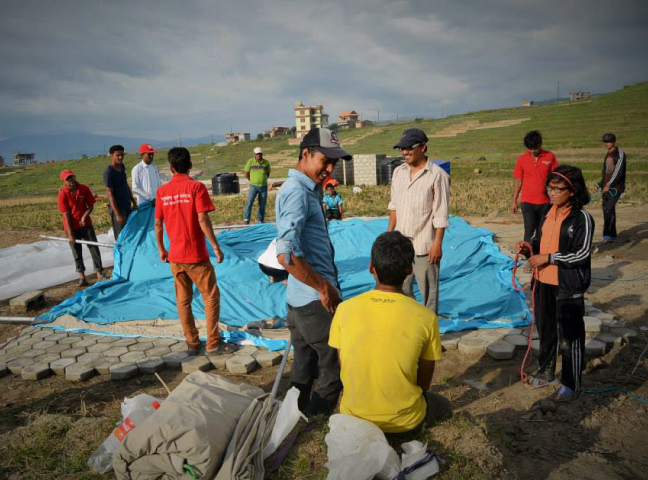
Students, workers and volunteers start building temporary classrooms, after the 2015 earthquake collapsed the school.
Photos by: Ram K Rijal, Bloom Nepal School; Metta Tours of Kathmandu
A team of people, in Nepal and in Washington state, have been rebuilding a school outside Kathmandu that was nearly destroyed by the 2015 earthquake.
Our group calls itself “Back on Track Bloom Nepal School.” The project started in August, 2015, when Seattle University intern Chandler Richards and I traveled to Nepal to learn about Bloom Nepal School, its needs, and how we could help.
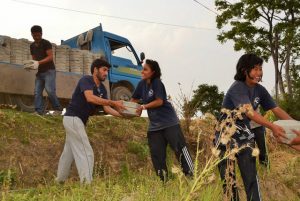
A chain of people move paver stones.
Nepal had been struck that April by a disastrous earthquake that killed more than 9,000 Nepalis and injured more than 23,000.
When we arrived we learned that the entire school was living in temporary shelters. Despite the numerous difficulties we were much impressed by the school’s founding team, and by the way they were continuing to educate the future leaders of Nepal under such difficult conditions.
The resiliency of these people manifested in many ways during our trip to Bloom Nepal School. After getting out of our vehicle a 20-minute walk away from the school, we crossed fields and hills and finally reached the damaged school’s tents and other temporary structures. There we received a warm welcome from the students and staff.
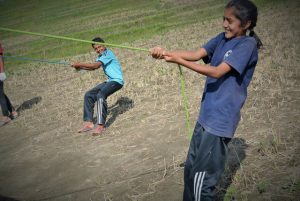
Pulling up the tent!
They gave us little wildflower bouquets they had made, simple, genuine and powerful, among the most memorable gifts we have received in our lives.
Though temporary and fragile after the earthquake, Bloom Nepal School remained a complete and well-kept school. Several classrooms, a library, separate girl’s and boy’s dorm rooms, a kitchen, eating halls, playground, and teachers’ quarters were placed beautifully in the middle of a green paddy field.
We toured the school, greeted the students, conducted several project meetings, and shared meals with the students and founders in the makeshift school lunchroom. The tasty healthy vegetarian Nepali meals, with several curries, lentils, vegetable salads and rice, were just what our bodies needed in the kindest way for their nourishment.
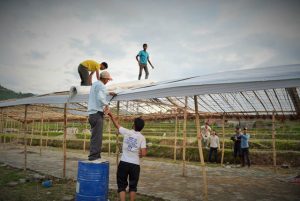
Standing on the new roof of a temporary classroom.
Having been in and out of classrooms with my children in the U.S., I was surprised to observe so many happy, energetic, and bubbly kids who were fully alert and eager to learn, despite the tragedy they had faced and the school’s inhospitable conditions. They exhibited no signs of trauma or loss from the earthquake, nor negative effects from living in shelters. They were purely happy beings living in the moment, who were ready to welcome us with smiles and open arms.
We had many meetings with the staff and founders, resulting in a project that inspired and gratified us. While serving as observers to the Bloom Nepal School Foundation Board, we have been working together on construction budgets, architectural blueprints, approvals, and permits. We also have helped the young founding leaders with strategy, fund raising, and ongoing mentoring and advice.
This earthquake was the cause that allowed us to give the way Buddha taught us, when he said of the ideal gift: “The donor, before giving, is glad; while giving, is inspired; and after giving, is gratified. The recipients are free of passion, aversion, and delusion.”
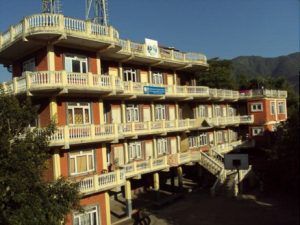
The main school building before the earthquake hit. (Note the basketball hoop in front, and see where it is in the next photo.)
As a novice meditator and member of the Eastside Insight Meditation sangha, in turn part of the larger Seattle Insight Meditation Society, this opportunity allowed me to apply my learning on the cushion to the wide world outside. Nepal is not only on the other side of the globe, it is the land of Buddha’s birth.
As many of you know, Nepal is a landlocked nation bordered by China and India, home to eight of the world’s 10 tallest mountains. Its 27.8 million people live on a per-capita income of $426 (U.S.) per year, making it quite poor by world standards.
I learned about the damage to the Bloom Nepal School through Wise Yak, a technology company in Nepal that is my client.
The earthquake had collapsed the main school building, and damaged some secondary buildings making them completely uninhabitable.
Sadly, two long-serving custodians died from the earthquake. Fortunately all of the teachers and students survived, some with minor injuries, which gave us the opportunity to help this school rebuild and get back on track.
Bloom Nepal School was founded in 2013 by MIT alumni Ram Rijal (See BNS story featured on MIT News) and his two high-school friends Rabindra Shrestha and Rajendra Bista. BNS is a fully residential, affordable school that offers high-quality, interest-based education to children of all backgrounds.
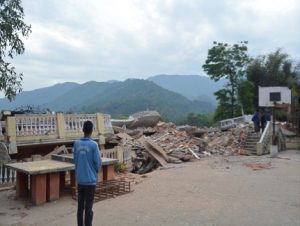
The same building after the earthquake collapsed it, killing two.
The school is outside the Nepali capital of Kathmandu, in a suburban area. The nearest bus stop is a 20-minute walk from the school. Here’s a Google map links to the exact location of the school: https://goo.gl/G7eUXX.
With the funds we have raised and generous support from people around the world, school leaders have been able to start rebuilding their school, to continue offering the gift of learning to its students.
So far rebuilders have completed two classroom blocks, each of which provides five classrooms and a residence hall in a 24-by-16-foot space. Each cost $18,000 U.S. to build. We’ve been constructing the buildings with pre-fabricated walls and ceilings, corrugated zinc roofs, concrete bases and a metal framework to support the structure.
The walls are assembled from a granulated insulation material called thermocol, sandwiched between two cement panels. These panels are engineered to defend against extreme weather conditions, and will last 20 years.
Upon completion of the remaining classroom block and the second residence hall, students will be able to shift from temporary structures of bamboo and tarpaulins to the new classrooms. The improved learning environment of the new classrooms will significantly contribute to better student outcomes. The school also will use the classrooms after normal class hours, as study spaces for interest-based learning.
Remaining projects include another classroom block, a teachers’ room, a laboratory, a kitchen, and accommodation for teachers.
At current capacity, this project will benefit approximately 150 students annually for the next 15 years. Students will come from many places from around Nepal.
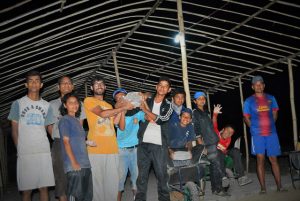
The human cheer of working hard together, to help each other.
The founders of Bloom Nepal School believe in passion-based learning. This refers to education that makes students very happy and engaged because it comes from within them, and not from their parents or from the need to belong to a profession that assures a certain income or status.
Bloom Nepal School’s mission is to grow Nepal’s next generation of engaged leaders, by providing affordable, specialized, passion-based education and the resources to ignite students’ creative thinking.
As we watched an evening sunset in a valley surrounded by huge mountains, near a very happy and blooming school, our tour came to the end. It was time to depart and our hearts felt it.
As Buddha said, parting from people you like and have come to love is suffering.
We knew we had no time to wait around suffering; we had a job do as soon as we came back to Seattle, this project.
There is much beauty in simplicity; Nepal and Bloom Nepal School taught me that. We were fortunate to be able to help fulfill their dream of a school where young people can study, to provide knowledge that can help them excel.
When I reflect on my journey, I feel I learned that giving, dana in Pali, is good for all of us. Sometimes we will be the recipients and sometimes the givers. Each of us always plays one role or the other in our lives – depending on the drama of our life that unfolds right in front of us at a given time!
